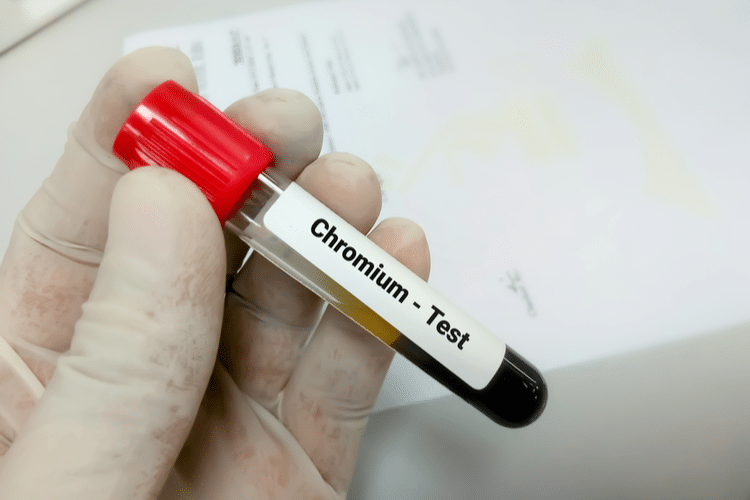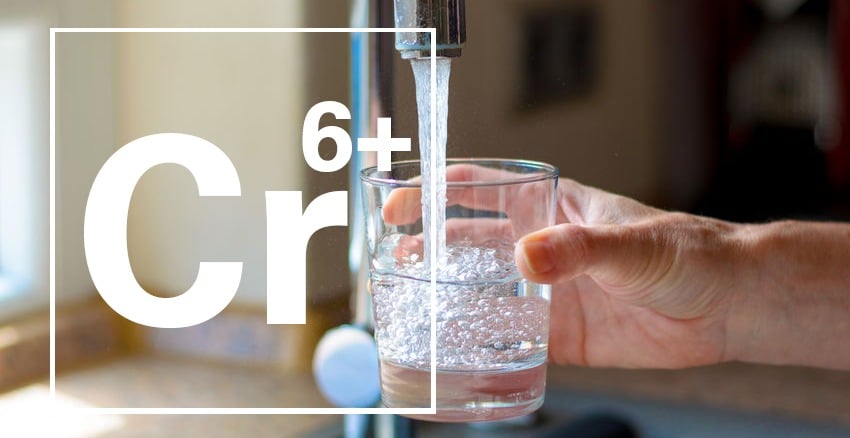Chromium 6 is a natural occurring element derived from eroding chrome deposits. It is used at different stages of the industrial process for large scale manufacturing. Natural gas and oil refineries also often use it as an anti-corrosion agent for cooling water.
It’s a highly carcinogenic chemical that is odorless and tasteless, and improper waste practices have caused this chemical to pollute water and air, making it a genuine threat to our health.
So, how is chromium 6 removed from water? The easiest and most effective way to remove chromium 6 from drinking water is through either reverse osmosis filtration or ion exchange water treatment.
| Chromium 6 Removal Method | The Best Product |
|---|---|
| Reverse Osmosis | Waterdrop G3 800 or Aquatru RO System |
| Ion Exchange (Water Softener) | Springwell SS1 Water Softener |
1. Remove Chromium 6 by Reverse Osmosis
Reverse osmosis (RO) systems are an excellent way to remove chromium 6 from drinking water. The RO process usually includes at least one activated carbon and one sediment filter, which reduces and removes large quantities of contaminants at once. The water then passes through a semi-permeable membrane that restricts particles that are larger than water molecules, stopping contaminants like arsenic, fluoride, and chromium.

However, note that these systems produce lots of wastewater. Most consumer-grade filtration systems generate up to 15 gallons of unusable water that needs to be drained.
That being said, the benefits easily outweigh the cons, and it’s one of the best ways to get rid of chromium 6 in water.
2. Remove Chromium 6 by Ion Exchange
Another effective way to rid your drinking water of chromium 6 is using an ion exchange water treatment unit, also known as a water softener. This type of treatment uses tiny resin beads packed tightly inside the columns. Minerals and other contaminants filter through these columns.
The beads act as catch-all that grabs ionic minerals as they travel through the system and eliminate them from the water. The drawback to this filtration methods is that it requires constant maintenance and cleaning because remnants of chemicals can build up inside the resin, reducing its effectiveness.
The Cost of Removing Chromium 6 from Water
Research teams in Glendale, California, tested methods for reducing and removing chromium 6 from groundwater on a large scale. The team revealed that it will cost an estimated $27 million over the next two decades to fund this effort.
State officials are hopeful that this is a step in the right direction. They are even going as far as setting a public health goal for reducing chromium 6 contamination. Their goal is to reduce it from 100 parts per billion to a staggering .02 parts per billion.
As for the individual consumer, the cost of removing chromium 6 from drinking water depends on the type of water purification or filtration system. The prices of reverse osmosis, ion exchange systems vary between $500 and $5,000.
However, High-end filtration systems often need to be professionally installed as well, and their filters should be replaced once every 6-12 months, depending on the use. So, the costs will add up in the long run.
How to Test for Chromium 6 in Water
You can either test your water yourself or let professionals handle it. You can find at-home testing kits online and at local hardware and home improvement stores.
However, the best and safest way to test your water is to contact your local health department for home water testing. In addition, you can send a water sample to an EPA-certified lab to get the most accurate and detailed result.

If the test results show that your water is contaminated by chromium 6, then it’s time to look for solutions.
What is Chromium 6 Water Contamination?
Chromium 6 occurs naturally in plants, rocks, and soil. However, the real threat emerges when it is used with an industrial purpose and carelessly disposed of.
For example, it was found in abundance in Hinkley, California, in the 1990s, leading to a contamination crisis. An Investigation led by Erin Brockovich resulted in a class-action lawsuit against the industrial plant, Pacific Gas and Electric (PG&E).
The plant used chromium 6 as a rust-suppressor and dumped the wastewater into the surrounding ponds of Hinkley, California. The wastewater contained an extreme amount of chromium 6, which seeped into groundwater and caused severe health issues for the Hinkley residents.
In addition to careless disposal, chromium 6 may also discharge from:
- Chrome plating
- Dye and painting pigments
- Inadequate storage

Health Effects of Drinking Chromium 6 Contaminated Water
Exposure to chromium 6 causes significant damage to the respiratory tract. The nature of the damage might vary from slight irritations on the inside of the nose to more severe problems like asthma.
Moreover, since it’s a highly carcinogenic chemical, it also increases the risk of cancer. A study done in 2015 revealed that workers exposed to chromium 6 had a higher risk of developing stomach cancer. In addition, evidence shows it also heightens the risks of lung and nasal cancers.
It can also cause reproductive complications by inducing apoptosis in male somatic and spermatogonial stem cells. As a result, there’s severe damage to sperm production and, subsequently affects the ability to reproduce.
What’s Being Done to Regulate Chromium 6?
There is no federal standard regulating the consumable amount of chromium 6, but the United States Environmental Protection Agency (EPA) has made efforts for regulation. According to the EPA, the total amount of chromium 6 in drinking water shouldn’t exceed 0.1 milligrams per litre or 100 parts per billion.
California lawmakers have taken extra steps to ensure the safety of drinking water. They established the maximum contaminant level of chromium 6 at 10 parts per billion.
In addition, the EPA regulates the waste and exposure to Chromium 6 on many fronts:
- Clean Air Act
- Clean Water Act
- Comprehensive Environmental Response, Compensation, and Liability Act
- Resource Conservation and Recovery Act
- Emergency Planning and Community Right-to-Know Act of 1986
- Federal Insecticide, Fungicide, and Rodenticide Act
- Safe Drinking Water Act
- Toxic Substances Control Act
Under the Safe Drinking Water Act, consumers must be provided annual reports on water quality, source of water, and any contaminants found in the water. These reports are delivered by public or private water suppliers.
Frequently Asked Questions
PUR water filters certified by the National Science Foundation can reduce up to 70 chemical substances but don’t remove chromium 6. Most faucet and countertop filters that use activated carbon can’t remove chromium 6.
While Brita filters are highly rated, it uses a carbon filter that cannot remove chromium 6 from water.
Because Berkey uses a gravity filter, their water filtration systems can reduce chromium 6 in the water. Berkey filters contain upwards of six media types constructed into compact microscopic holes.
Water passes through the holes without allowing in chromium 6. The next step in the process includes an ion exchange. This exchange attracts the contaminant molecules. Chromium 6 is absorbed and bonds to the filter.
Zero Water filters are rigorously tested per the National Science Foundation’s protocols. They claim to remove 99% of chromium from drinking water.
These filters work much like the Berkey filter, absorbing chromium 6 before it reaches the reservoir chamber. Zero Water and Berkey filters are cost-effective options for removing chromium 6 from drinking water.